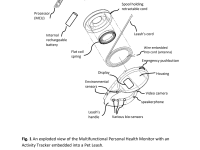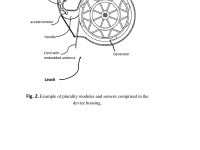Digital health monitoring has reached millions of individuals, but the vital human-dog couple is missed.
Consider a dog attached to a retractable leash pulls the cord, which rotates the leash's spool. The leash functions as an embedded electrical generator, resulting in the dog's kinetic energy powering multiple embedded into the leash sensors that collect, analyze, transmit the duo's health and activity data, Figure 1.
The firm dog walker's grip provides reliable contact with bio-sensors embedded into the leash's handle. The leash's plentiful case hosts multiple bio-sensors and user interfaces, e.g., microphone, display, GPS, accelerometer for fall detection, RF modules for communication.
The human-dog bond isn't only emotionally priceless; it lowers stress, the risk of asthma, blood pressure, stimulates physical activities. Studies have shown dogs can detect malaria, Parkinson's before symptoms appear, seizures, COVID-19, cancer. Heart failure, the leading cause of death, is a race against time; warnings are easy to miss if a heart is only occasionally checked at a doctor’s comfortable office. Aggregated data from millions of users, systematically walking dogs enhances health analytics, can point to chronic trends, predict a disease epidemic. Thanks to crowd participation, 23andMe announced a milestone in cancer-developing drugs. GPS-mapped digital health data shows public geo-health tendencies; the major players in that arena are Apple, Google, Intel, Amazon, Microsoft, Fitbit.
Dogs help soldiers, police, first responders, medics, poacher-hunters; they operate in remote locations and extreme situations, requiring constant, preferably effortless, monitoring. Recent DoD FA8650-22-S-5006 calls for "developing wearable systems to continuously monitor biometrics of fatigue and stress using electrophysiological modalities and biomarkers of stress."
Modern electronics enable wrist-worn fashion devices employing a small battery and several sensors. To continually acquire delicate signals (ECG/EEG/EMG/EOG/PA), the contact between the electrodes and skin must be reliable, which is challenging for loosely worn armbands. Emerging devices, e.g., non-invasive glucose monitors, consume significant power, making them unrealistic to implement in armband monitors.
Ironically, the limiting factor is not electronics; mighty Systems-on-Chip are tiny; the game-stopper is the lack of power and space for sensors.
The leash as a data logger addresses the shortcomings, see Fig.1,2; inexpensive components are OK, the spool resembles a rotor, the production cost impact is minimal. The design is straightforward; software simulates bio, environmental (CO2, contamination, radiation) sensors, MEMS, analog-to-digital conversion, and data processing; intricate computations are done in the cloud. If the communication is challenged, the cord-embedded wire functions as an antenna, boosting Wi-Fi, cell, satellite links.
There are ~90M dogs in ~60M US households; for many senior citizens, a dog is a reason and often the only companion for daily activities, some you mustn’t miss, thus tying recorded telehealth to repeatable sessions. Remember the commercial, “I’ve fallen and can’t reach my phone”? The leash would initiate an emergency call; it is a path to active life, explorations, digital health, big data, artificial intelligence, biometrically encrypted records, communications with loved ones, and critical decision-makers for updates and assistance.
Internet of Dog-Lovers, Figure 3, creates worldwide collaboration for unique medical and social discoveries.
Like this entry?
-
About the Entrant
- Name:Samuel Kerem
- Type of entry:individual









